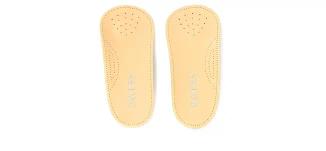
Maximising Comfort: Using Insoles to Perfect the Fit for Shoes That Are Too Big
10 September 2024
Finding the perfect pair of shoes shouldn’t be a stressful experience, but if you’re the proud owner of some that don't quite fit, we’re here to help. Here at Pavers, we specialise in connecting our readers with comfortable, stylish, and well-fitting shoes - even if it requires using an insole or some other technique to make slight size adjustments.
So, if you have ordered shoes slightly too big but you just couldn't resist, read on. Here’s what we’ll cover:
- Understanding the challenges of oversized shoes
- Choosing the right insoles for your shoes
- Tips for using insoles effectively
You can also browse our cosy and classic shoes, as well as our premium comfort features, over at The Comfort Hub. Or, if you’d rather jump straight to a new pair of insoles, you can do that too.
Understanding the Challenges of Oversized Shoes
Shoes that are too big can lead to several problems in the short and long term. These range from discomfort that goes away when you take the shoes off, through to damage to your feet that can be long-lasting or even permanent.
Here are some common issues from wearing oversized shoes:
- Discomfort from friction: your feet have more space to move around in an oversized shoe, and the resulting friction and bumping can lead to blisters, calluses and other discomfort.
- Absence of proper foot support: the lack of proper support caused by the shoe not fitting well with your foot can lead to arch pain and other complaints.
- Altered gait: as you try to compensate for the incorrect fit, you’re likely to walk differently, which can lead to aches and pains in your knees, hips and other areas.
- Poor posture: posture can be impacted as well as gait, with the likelihood increasing over time.
- Higher risk of falls: you’ll be less stable in shoes that are too big, raising the chances of taking a tumble.
As you can see, there’s a pretty convincing case for avoiding oversized shoes! And thankfully it’s easier than you might think to improve the fit of a pair that are slightly too large.
Choosing the Right Insoles for Shoes
If your shoes are too big and you’d like to try insoles to remedy the situation, here are some of the main types. We’ve linked to individual products where relevant; you can also take a look at our full foot care range.
Full-length Insoles
As the name suggests, these cover the full length of the shoe and thereby provide support and cushioning to your whole foot - including toes and heel. Full-length insoles are a good choice when your shoes are too large as they offer a more secure fit.
Three-quarter Length Insoles
These shorter insoles cover three quarters of the shoe, from the heel forwards. The lack of toe support lends itself particularly well to styles of shoe where you don't want to add bulk to the toe box. They’re a good choice for shoes that are slightly oversized.
Half-length Insoles
Half-length insoles are - you guessed it - insoles that cover half the length of your shoe: namely the area near the ball of your foot through to your toes. These are a good choice if your shoes are slightly too big in the toe area, or if you want extra cushioning without changing the fit around the heel.

Heel Liners
These small pads slide into the back of your shoe to improve the fit around the heel area, and are the ideal choice if your shoes aren’t so big that they require a full insole. They’re also a good way to protect against heel blisters.
Arch Insoles
Tips for Using Insoles Effectively
With the right type of insole identified, here are some tips for using them properly. Follow the guidance below and you’ll be well on your way to a more comfortable fit, with no risk of inadvertently making the problem worse.
Proper Installation Techniques
First, remove any insoles that came with the shoe. This has the combined benefit of giving a clearer idea of the situation and allowing the new insole to fit better.
Full-length and three-quarter length insoles can be trimmed to fit and will include guidelines to help you do this. Make sure the insoles are the right size before you start using them.
Ensure the insoles lie completely flat inside the shoe: bumps and wrinkles are a sign of a poor fit and can lead to discomfort. Some insoles will have adhesive pads to keep them in the right place - definitely make use of these if you have them.
Adjusting Insoles for the Best Fit
Installed an insole with the steps above and still finding the shoes aren’t quite the right fit? Remember you can layer insoles: a heel liner can be used on top of a full-length insole, for example.
Walk around a bit once the insoles are in and give them a chance to settle. Also for your feet to get used to them. If they’re still feeling a bit off, double-check the size, the fit, and whether you can trim them down any more to be a better fit.
How Long Should You Wear Insoles For?
With some types of insoles, like arch support ones, gradually increasing the amount of time you spend wearing them can be helpful. This is because they can be uncomfortable and feel unusual. Wear them for a few hours each day and give your feet time to adjust just as you would with a brand-new pair of shoes.
Over time as your feet adjust and your shoes expand through use, you may find your need to change your insole. They might become redundant, in which case you can switch back to the original soles, or you might find you need a different type.
The short answer for this question is, “Of course, the best way to tell if the insole is right for you is that it feels right.” If they start having the opposite effect, re-evaluate and decide the best course of forward action.
The Importance of Choosing Well-Fitting Shoes
While insoles can certainly help with oversized shoes, it’s important to remember that the best way to ensure long-lasting comfort is by starting with shoes that fit you perfectly. At Pavers, we offer a wide range of shoes designed to accommodate various needs, from arch support to wide-fit options. When you invest in well-fitting shoes, particularly those with built-in support features, you may not even need insoles to enhance comfort or fit. Shoes that are tailored to your foot shape and support needs can provide the perfect balance, eliminating many of the common discomforts associated with ill-fitting footwear.
Come In Store for Further Help and Advice
Buying shoes that fit well is the best way to guarantee a comfortable fit, but there are plenty of ways to find yourself with a pair that isn’t quite right. If this is the case, we hope this guide has reassured you that there is a way forward, and that you don’t need to get rid of them right away.
With the right pair of insoles, you can make an impressive difference to an ill-fitting shoe. Follow the guidelines above and you’ll be able to get the right insoles, to install them correctly, and to enjoy a more comfortably fitting pair of shoes for years to come.
If you’re looking to buy a new pair of well-fitting shoes, take a look at our range today. Our comprehensive selection has shoes of all fashions and sizes to make sure you get a comfortable fit that aligns with your personal style! If you need more advise, get in touch with either online or in-store with our team and we’ll be happy to help.

